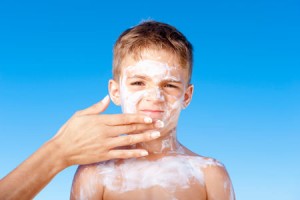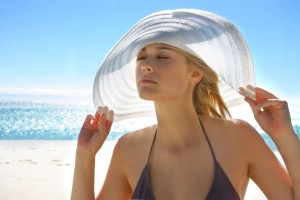The summer is upon us! As we creep out from inside our homes and into the blasting rays of the sun, we must remember to protect ourselves, but more specifically our skin. Sunscreen helps achieve this!
Year round we hear about sunscreen and all of its profitable qualities.We see at least one commercial about sunscreen everyday and the term ‘SPF’ is embedded into our minds. Although we are knowledgeable about sunscreen, we sometimes either forget to put it on or we put it on incorrectly.
This is a costly mistake because about 3.5 million cases of skin cancer will be diagnosed this year.
According to Dr. Ronald Moy, a dermatologist and spokesperson for the Skin Cancer Foundation, “The incidence of skin cancer, including melanoma — the deadliest kind — is going up, and wearing sunscreen is one of the best ways to prevent it.”
So skipping out on sunscreen to go to the pool or for a jog is risky!
Get the Best Out of Sunscreen!
The benefits to sunscreen are so great that the only way you lose is if you don’t put it on. Its a win-win situation with not only protecting your skin and yourself from getting skin cancer; but you will get to enjoy outside even better because of it!
Skin Cancer is very serious and not taking the proper precautions to prevent it is unreasonable.
Here are the BASICS to getting the most out of your summer this year!
How to Pick It!
Finding a good sunscreen is like finding a deodorant that you enjoy; you have to be able to use it all the time and be satisfied with its properties.
With that being said, the more you like the sunscreen, the easier you’ll remember to put it on, like a nice perfume. Not all sunscreens are good ones! Some are sticky, thick, smelly, or pasty. If the one you are thinking about choosing is any of these then that is the WRONG kind! The less appealing it is to you the more likely you will not want to put it on.
There are many lightweight, easy on the scent and sheer, sunscreens out there. There are many sites that have detailed lists that can help you find the perfect one!
SPF
The next thing to remember is the SPF of the sunscreen. The SPF, or sun protection factor, refers to the ability of a sunscreen to block ultraviolet B (UVB) rays, which cause sunburns but not UVA rays, which are more closely linked to deeper skin damage.
Both UVA and UVB contribute to the risk of skin cancer.
As a general rule, SPF 15 blocks 93% of UVB rays, SPF 30 blocks 97% and SPF 50 blocks 98%. Doctors now typically recommend at least SPF 30 — at least being the key words.
If you have a family history of skin cancer or are vacationing in a tropical spot (where the sun is especially intense), go for 50 or even 70.
Just realize, no sunscreen provides 100% protection. So the necessary steps need to be taken to have a continuous barrier on your skin. This includes reapplying the sunscreen every two hours and after you swim.
One other important thing, make sure you purchase a new container of sunscreen before it hits the three year mark. After that, it becomes less effective.
“Broad-Spectrum”
Also when picking a sunscreen, make sure the label says “broad spectrum. This means that it protects against both UVA (wrinkle- and cancer-causing) and UVB rays (burning).
Not all labels are current with this term due to this rule of having broad-spectrum present went into affect this past December. So if it does not say it on the label, look at the ingredient list for zinc and avobenzone.
How to Apply it!
Almost no one ever puts on enough sunscreen. We throw on one layer the first time and keep it moving.
“Several big studies show that most people rub in only about a fourth of what’s needed..” according to Jeffrey Dover, clinical associate professor of dermatology at Yale University.
Instead of that old advice to use a shot glass-size dose, all our experts recommend applying two coats.
Squeeze a line of lotion down your arms and legs and rub in, then do it again. Ditto for spray formulas: hold the nozzle close to your skin and spray, moving slowly up and down until you see a sheen, then go back over the area.
For your face, apply a pea-size drop to each cheek, your forehead and your chin, then smear in. Repeat!
Don’t forget your nose and antioxidants!
It’s the number one sunburn-spot, dermatologists say. 80% of the skin cancers I remove are on the nose.”, says Dr. Ronald Moy.
Other commonly missed areas include the feet, hair part, ears and chest, as well as the backs of hands and legs. Use a sunscreen stick to spot-apply.
Sun rays can still get through sunscreen, companies are now including antioxidants such as vitamins C and E and green tea to help mitigate damage.
Be Reasonable and Positive!
“The hierarchy of sun protection should be avoidance first, then seek shade and wear a wide-brim hat and protective clothing, then use sunscreen — but most people have that sequence backward,” says Dr. Steven Wang, director of dermatologic surgery and dermatology at Memorial Sloan-Kettering Cancer Center in Basking Ridge, New Jersey.
Consider hitting the beach or pool in the morning instead of midday (when sun is strongest), and bring an umbrella and a tightly woven long-sleeve shirt.
The last thing to know that even though you got away with not putting on sunscreen as a teen and young adult, you need to begin to put it on as soon as possible. While regular tanning or getting several bad burns when you’re young raises your risk of skin cancer.
The ability for the skin to repair itself decreases with age, your risk is even greater if you burn now as an adult or older adult. So start the safe habit now!
So with this information, sunscreen should be just as important as toothpaste in your everyday life!
Happy Summer!




